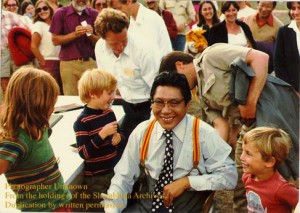Wednesday
Featured StoriesThe Shambhala Holidays
article by Andrew Forbes, New York CityFor many of us, the recent solstice celebration rang in the holiday of Children’s Day, where we gathered at our local centers on the longest night of the year by candlelight and song. The King and Queen welcomed and blessed the children’s assembly marking a day in which we can celebrate the rebirth of the sun, the beginning of winter, and when the animals and plants return to the earth for slumber and rejuvenation. The children, teens, and grown-ups all took part in plays, carols, poems and celebration. This is one of the several major holidays celebrated within the Shambhala community.
Holidays are important not only because they are a religions’ calendar of community activities, but that they mark the movement of the earth around the sun, the movement of the stars, and the story of our journey through the galaxy. It is a way in which we as people can relate to the vast vision of the cosmos, understand our place in it, and conduct ourselves to gather auspiciousness and virtue. By following the movement of the seasons and the stars, we may understand the story of humankind.
Amazonian traditions would consult their tribal shaman every year, and through ingesting the sacred plant of ayuasca, calculate the yearly festivals according to the movement of our planet through the constellations, and be able to predict the years’ major days of harvest and times of struggle. This was the only use for the ayuasca medicine in many tribes.
The Tibetan regional culture of Bon, an ancient system of central asian shamanism, the systems of Ayurveda (Indian yogic medicine), and Taoism all approached their own traditional festivals in similar light as the druidic peoples of ancient Europe. These pagan holidays follow a very practical schedule, according to the yearly lunar cycle and the movement of the seasons. Chogyam Trungpa Rinpoche had an appreciation of the celtic tradition that adhered to these holidays, and since Shambhala houses the wisdom of these traditions, saw them as seminal in the integration of Shambhala into western culture.
The holidays themselves mark the yearly patterns of agriculture, and therefore business: how to gather and consume resources sustainably, respecting the environment that supports life.
 It is a story, a tale of death, regeneration, rebirth, innocence, childhood, love, marriage, harvest, autumn, and then death again: a cycle of reincarnation of all life as Earth continues on its path around the sun. In the Celtic system, the holiday of Samhain (November 1st) is the new year, whereas in Shambhala, the holiday of Tibetan Losar, or Shambhala Day, is the new year. On Samhain, the festival is marked by the death of the old, and laying down the expired nutrients of the earth to regenerate and transform into potential fertilizer during the winter months. On Shambhala Day, which is closer to the Celtic Imbolc, in February/March, the coming spring heralds rebirth, and the young infant may step into a fresh world that is ready to come about only from the fertilized ground that was prepared during the long winter.
It is a story, a tale of death, regeneration, rebirth, innocence, childhood, love, marriage, harvest, autumn, and then death again: a cycle of reincarnation of all life as Earth continues on its path around the sun. In the Celtic system, the holiday of Samhain (November 1st) is the new year, whereas in Shambhala, the holiday of Tibetan Losar, or Shambhala Day, is the new year. On Samhain, the festival is marked by the death of the old, and laying down the expired nutrients of the earth to regenerate and transform into potential fertilizer during the winter months. On Shambhala Day, which is closer to the Celtic Imbolc, in February/March, the coming spring heralds rebirth, and the young infant may step into a fresh world that is ready to come about only from the fertilized ground that was prepared during the long winter.
Then comes the spring equinox, where the infant becomes a youth, and then Mayday, where our youth falls in love. Following is midsummer’s day, where the love of youth is in full bloom, and life on earth has reached maturity. The next holiday in the cycle, falling nearest the full moon of August 1st, is the first harvest festival. This is a holiday of marriage, when love ripens into friendship, and the bond for the foundation of the continuity of humanity is forged.
Harvest of peace, or Mabon in the pagan tradition, is the second harvest festival, where the crops are yielding the greatest nutrients, and the sun is beginning to turn towards the darkness. It is time to begin to prepare for the coming winter, a time of celebration, to feast and fatten and enjoy the fruits of summer labor, and to rest and prepare to allow old age to mature. With the coming of death, the year may begin again. That is why it is said that on the festival of Samhain, November 1st, the veils between the dead and living are at their most subtle. As the world grows cold, the sun fades away, leaving the days short and the nights long. The world grows quiet.
Then on the day of winter’s solstice, the sun begins to return, and the days of fertilization and transformation begin. With the cold of winter, the earth enters it’s slumber, transforming the dead leaves from the autumn into fertilizer for the coming years’ growth. Finally, as the winter begins to loosen its grip, the promise of spring’s return shows it’s first budding upon the trees, and the animals begin to emerge from their underground refuge. From the winter’s womb the newborn cycle may boldly take the first step into the fresh year.
Thus the cycle continues through the seasons, and through the twelve-year cycles, through the ages, through the eons, and through the life of our planet and the beings that dwell upon it as it hurls through space endlessly orbiting the Milky Way.
 ~~
~~
Andrew Forbes is a practitioner, teacher, and scholar of Dharma Art, Shambhala, Buddhism and world religious traditions. He holds a degree from Naropa University, and lives in New York City.






Dec 26, 2013
Reply
Some interesting information. Thanks Andrew!